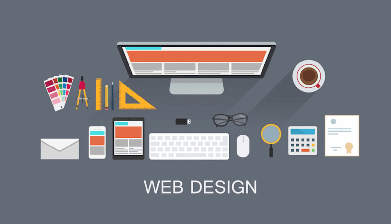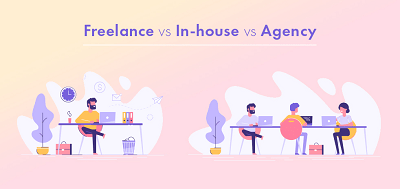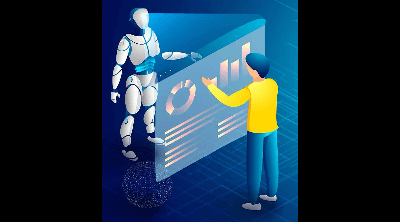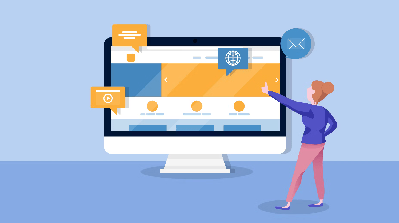The Intersection Of SEO & Web Design
The intersection of SEO (Search Engine Optimization) and web design is a critical aspect of creating a successful and user-friendly website that ranks well in search engines. The way a website is designed can significantly impact its visibility in search results, user experience, and overall online performance. Here are key points to consider at the intersection of SEO and web design:
- Mobile-Friendly Design: With the prevalence of mobile devices, having a responsive and mobile-friendly design is essential. Google considers mobile-friendliness as a ranking factor, and a mobile-friendly site ensures a positive user experience on all devices.
- Page Speed: Website speed is a crucial factor for both user experience and SEO. Slow-loading pages can lead to higher bounce rates and lower search rankings. Web design should prioritize optimizing images, minimizing code, and utilizing browser caching to enhance page speed.
- User Experience (UX): A well-designed website should prioritize user experience. Intuitive navigation, clear layout, easy-to-read fonts, and organized content contribute to a positive user experience, reducing bounce rates and improving SEO.
- Site Structure: A well-organized site structure makes it easier for both users and search engines to navigate your website. A clear hierarchy and logical linking structure help search engines understand the importance of various pages and how they relate to each other.
- URL Structure: Creating clean and descriptive URLs helps search engines and users understand the content of a page at a glance. URLs should reflect the content hierarchy and include relevant keywords.
- SEO-Friendly Design Elements: Design elements such as images, videos, and multimedia should be optimized for search engines. This includes using descriptive alt text for images and providing video transcripts to make content accessible to search engines.
- Content Placement: Strategic placement of high-quality content is important for both users and SEO. Essential information should be placed prominently, and relevant keywords should be used in headings and body contentEnsure search engine bots can easily crawl and index your website. This involves having a clear link structure, avoiding complex JavaScript that might hinder crawling, and utilizing tools like XML sitemaps.
- Schema Markup: Incorporating schema markup can provide search engines with additional information about your content, improving the chances of rich snippets appearing in search results and enhancing click-through rates. Flash-based designs can be problematic for SEO as they’re not easily accessible to search engines. Using modern web technologies like HTML5 and CSS3 is more SEO-friendly.
- Avoid Duplicate Content: Proper design practices can help avoid duplicate content issues that might arise from multiple URLs displaying the same content. Canonical tags and consistent URL structures can mitigate this problem.For businesses targeting local audiences, including local contact information, business hours, and maps can improve local search visibility.
In-House Web Design vs Freelancer vs Agency
In-house web design involves hiring full-time web designers to create and maintain a website for a company. In-house design provides a company with a team of dedicated professionals who can quickly implement changes and troubleshoot any problems that arise. This allows the company to stay on top of the latest design trends and ensures the website is consistently up to date. In addition, because the web designers are familiar with the company, they can anticipate its challenges and design a website that accurately reflects its brand and goals. However, in-house design also comes with its own challenges. To maintain quality, in-house web designers must stay up to date on the latest trends and technologies, and this requires a considerable investment in training, as well as a steady influx of talent. In-house design can also be more expensive, as the company needs to pay salaries and benefits for the web designers.
Freelance web designers offer a cost-effective alternative to in-house design. These designers work independently, without the need for full-time staff, and they are more affordable than in-house web design services. Freelancers often have specialized skills that can be invaluable to a company. They can provide custom design services that a company’s in-house team may not be able to offer. However, working with freelancers can also be risky, as there is no guarantee of quality or timely delivery. The freelancer may not be familiar with the company’s brand or goals, making it difficult to achieve the desired results. There is also the concern that the freelancer may be unreliable or that the finished product may not match the company’s expectations. A web design agency provides a reliable alternative to both in-house and freelance web design services.
A web design agency has the resources and expertise to create and maintain a website that accurately reflects a company’s brand and goals. By working with a team of experienced professionals, a company can ensure that the website reflects its mission and values. Furthermore, an established web design agency will have the resources to take on complex projects and can provide a steady stream of innovative ideas. Web design agencies also come with built-in accountability, as they are accountable to the company’s performance and are expected to maintain commitment to quality. However, a web design agency can be more expensive than working with an in-house or freelance designer. A company will need to invest in the agency’s services and may need to pay for additional support services, such as ongoing maintenance and updates.
How AI software will change architecture and design
In the architecture and design industries, Artificial Intelligence (AI) has emerged as one of the most disruptive digital technologies. AI can be used to improve productivity, facilitate day-to-day operations, provide insights, and create entirely new forms of design and architecture. AI software can be applied to various areas of design and architecture including digital project management, automated drawings and simulations, robot-assisted structures, big data analytics, and more. This article will discuss how AI software will change the architecture and design industries.
First, AI software can be used to automate mundane, repetitive tasks such as drafting plans and designing building layouts. This will allow architects and designers to spend more time on creative problem solving and design innovation. By taking the time-consuming aspects of the design process out of the equation, AI software can also enable architects and designers to operate more efficiently and with greater accuracy. In addition, AI software can be used to reduce the costs associated with designing projects by eliminating the need for manual labour, physical prototypes, and other costly materials.
Second, AI software can be used to generate design concepts based on patterns and trends in the data. With the help of AI, designers can use data sources such as historical architectural styles and public opinion surveys to develop innovative designs that meet individual client requirements. At the same time, AI can help to create 3D models of entire building structures, saving time and resources by automatically generating detailed designs from a set of input parameters.
Third, AI can be used to optimise the building process by making the construction process more efficient and cost-effective. AI can be used to forecast the demand for materials, allowing designers and architects to build structures more quickly and efficiently. Additionally, AI can allow for the simulation of multiple design and construction scenarios, providing insights into potential energy savings and safety considerations.
Lastly, AI will also revolutionise the way we interact with the built environment. AI-based services will enable us to use our voice or other natural forms of communication to interact with our environment. These services can be used to help us navigate complex structures, access information, and provide recommendations to improve the design.
Web Design Project Management Systems That Improve Business Efficiency and Profits
Web design project management systems are critical tools for businesses to improve their efficiency and profits. By making the process of web design more organized and systematized, project managers can easily monitor and update project progress and remove impediments to success.Project management systems help businesses maximize profits, increase customer satisfaction, reduce costs, increase utilization of resources, and better track the progress of projects. The most commonly used system is the Gantt chart, which provides a graphical representation of a project that displays its timeline and key milestones. This type of chart allows project managers to quickly identify areas of delay or under-utilization of resources, and take corrective action. Gantt charts can also be integrated with other systems, such as task management applications and customer relationship management systems. In addition, web design project management systems can be used to allocate resources effectively. By tracking the utilization of skills and talent across a project, critical personnel can be assigned to important tasks before they become under-utilized. This can help reduce costs and improve efficiency.
The use of web design project management systems also helps business owners maintain consistent quality standards and reduce the risks associated with change. By using project management systems, businesses can develop a consistent process for reviewing progress and ensuring that changes meet the organization’s quality standards and objectives. Finally, web design project management systems are helpful for collecting and analyzing data. Project managers can use them to measure customer satisfaction, track changes and improvements, measure success relative to deadlines, and track the cost of each task. This data can be used to develop solutions that increase customer satisfaction and reduce costs. In conclusion, web design project management systems are powerful tools that can help businesses improve their efficiency and profits. They allow project managers to quickly identify and address issues, allocate resources effectively, maintain consistent quality standards, and gather and analyze data that can help them make better decisions. By using web design project management systems, businesses can create a well-structured, successful project that will maximize their profits and ensure customer satisfaction.
Bringing Biomimicry To UX Design
Biomimicry is an evolutionary design approach that uses biological processes and systems as a model for how to solve design problems. This method of design has been growing in popularity among UX designers and has been successful in providing solutions to a variety of design challenges. Biomimicry is based on the idea that nature, in its millions of years of evolution, has already developed many effective solutions to the problems that a designer faces. Instead of reinventing the wheel, biomimicry borrows from nature’s successes and applies them to the design of products and services. The purpose of bringing biomimicry to a UX design is to create a design that works in harmony with the environment and with the user’s needs. By understanding how the natural systems that make up a product or service works, designers can create designs that are more intuitive, user-friendly, and cost-effective. For example, a UX designer who wanted to develop a navigation system could look to the way birds fly in flight for inspiration.
By understanding the navigation systems of birds, designers could develop a system within an app that is easier to use, more efficient, and intuitive for the user. The primary benefit of biomimicry for UX design is that it provides a deeper understanding of the user’s needs and environment. Rather than simply looking at what’s already been done, biomimicry enhances the design process by understanding how nature works and then applying it to the user experience. Biomimicry also gives a designer the opportunity to think outside the box and create solutions that may not have been considered before. By understanding how nature works, a designer can think of solutions that may seem unconventional but are often more effective than more traditional solutions. Ultimately, biomimicry is a powerful tool for UX designers to use in their design process. It provides an opportunity to create designs that work in harmony with the user’s environment and needs. By taking what nature has already developed and applying it to design challenges, designers can create more intuitive, user-friendly, and cost-effective solutions.
Get to Know All the Aspects of Web Design to Build the Business Online Successfully
Web Design is the process of creating a visually appealing website that is easy to navigate and functional. It involves various aspects such as layout, typography, colour scheme, graphic design, content creation, user experience design, etc. With the right combination of these components, you can create a website that will help you meet your business goals. Layout: The first step is to decide on the layout of the website. Choose a design that will best suit your target audience. Think about the feel you want to give to your audience and how you want to organize the information. You must also determine the look and feel of the website, including fonts, graphics and colors, and you must decide how the content should be organized for maximum impact. Typography: Choosing the right typeface is important to succeed in web design. Typeface can make or break a design and must be used in a manner that will be pleasing to the customer. It is also important to pay attention to the font size, weight, leading, tracking and kerning when designing a website. Colour Scheme: Colour can influence a website’s look and feel.
You must choose the colours carefully so that they are pleasing to the eye and help create the desired mood. You should also be aware of the colour theory when selecting your colour palette. Graphic Design: Graphic design is the art of combining type, images, photos, animations or videos together to help people understand a message. Your choice of graphics will help to set the mood, convey the message and highlight your brand. Content Creation: Content is the heart and soul of a website. Good content will attract the customer’s attention, help them understand the product or service, and convince them to buy. The content should be well written, grammatically correct and easy to read. User Experience: The user experience is the way a visitor interacts with a website. It includes user interface design, navigation, and other elements. Good user experience will help keep the customer engaged and focused on the content. By understanding all the aspects of web design, you can create a website that will be effective in helping you meet your business goals. With the right combination of design, content and user experience, you can build an attractive website that will help you reach a larger audience.
Website Design Company Services Market Is Booming Worldwide
The demand for website design company services is soaring globally due to the growing awareness of the importance of the internet for businesses. Companies of all sizes today recognise that having an online presence is an important part in their success. It has become an integral part of brand development and sales conversion, particularly for start-ups and SMBs. Website design companies provide critical services when it comes to creating an effective website. Such services include the definition and understanding of an organisation’s objectives, the development of a customised website built on a technology stack, SEO and content management, e-commerce solutions, and social media integration. These services help companies reach their target audience and provide them with the information, tools, and resources they need to connect and engage. Digital marketing has also become an essential aspect of successful businesses. E-commerce, search engine optimization (SEO), and pay-per-click advertising (PPC) have always been a key element, but there is an increased emphasis on data analytics. Companies need to understand their customers to better deliver the right content, products, and services. Website design companies provide services that help companies interpret and analyse data to better understand these customers and develop campaigns accordingly.
Not only do website design companies offer a comprehensive range of services, but they have also expanded their clientele to include start-ups, SMBs, and large organisations. Companies must have the right website to remain competitive. It should reflect the company’s core message, purpose, and branding. A website design company understands the business’s target audience and customises the site accordingly. With technology becoming more and more accessible, website design companies will continue to see increased demand. Everyone from big companies to individual entrepreneurs need to have an online presence. The demand will continue as companies require more sophisticated offerings, such as website personalisation, augmented reality, and artificial intelligence. In short, website design services are becoming a critical part of businesses of all sizes. They offer a range of services that help companies to reach their target audience and remain competitive. With technology advancing, they will continue to see an increased demand for their services as they remain a key element to success in the digital age.
Research Shows Bad Website Design Has Been Turning Customers Away
In the world of ecommerce, the customer experience is more important than ever before. If a customer lands on a website that has a poor design, they are likely to leave the site without making a purchase. This is a major problem for companies, as it can lead to lost revenue and customer loyalty.
There are many reasons why bad website design can turn customers away. For starters, a poorly designed website can make it difficult for customers to find the information or products that they’re looking for. This can lead to frustration and a feeling of being overwhelmed. If a customer cannot find what they are looking for quickly and easily, they are likely to leave the website and look elsewhere.
Another reason why bad website design can turn customers away is due to the overall look and feel of the website. If a website looks outdated, cluttered, or unprofessional, customers may not feel comfortable making a purchase.
Additionally, if the website is slow to load, customers may become impatient and leave the site before they have a chance to explore it.
Finally, bad website design can also impact the customer’s trust in a company. If a website is difficult to navigate or doesn’t have clear and concise information about the company, customers may not feel comfortable making a purchase. Additionally, if a website has poor security measures, customers may be worried about the safety of their personal information.
Bad website design can have a drastic effect on a company’s bottom line and customer loyalty. Companies should take the time to ensure that their website is well-designed, easy to navigate, and secure. This will help to ensure that customers have a positive experience and are more likely to make a purchase. Additionally, companies should regularly review their website design to ensure that it is up to date and meets customer expectations.
5 Good Reasons to Invest in Mobile-Oriented Web Design
Mobile-oriented web design is quickly becoming a necessity for businesses that want to stay competitive in today’s digital landscape. With more and more people relying on their mobile devices to access the internet, it’s essential for businesses to ensure their websites are optimized for mobile users. Here are five good reasons to invest in mobile-oriented web design.
1. Improved User Experience: Mobile-oriented web design provides users with a much more user-friendly experience on their mobile devices. Features such as responsive design and adaptive layouts ensure that the website looks and performs great across all devices. This allows customers to navigate the website easily, find the information they need, and complete tasks with minimal effort.
2. Increased Accessibility: Mobile-oriented web design makes a website more accessible to a broader audience. Mobile-friendly websites are optimized to load quickly and display correctly on any device, allowing customers to access the website regardless of where they are or what device they’re using.
3. Increased Visibility: Mobile-oriented web design also allows businesses to reach a wider audience. Google now gives preference to websites that are optimized for mobile devices, meaning that businesses with mobile-friendly websites are likely to rank higher in search engine results pages.
4. Increased Conversion Rates: Mobile-oriented web design can also help businesses increase their conversion rates. By making the website easier to use, customers are more likely to stay on the website for longer and complete tasks, such as making a purchase.
5. Increased Revenue: Finally, mobile-oriented web design can help businesses generate more revenue. By making the website easier to use and more visible, businesses can attract more customers and convert more of them into paying customers.
In conclusion, mobile-oriented web design is quickly becoming a necessity for businesses that want to stay competitive in today’s digital landscape. By investing in mobile-oriented web design, businesses can enjoy improved user experience, increased accessibility, visibility, conversion rates, and revenue.
The Horrifying Problem With the Way Web Design and Development Is Taught
The way web design and development is taught is a horrifying problem because it fails to equip students with the necessary skills to make a successful career in the field. There are many different aspects to web design and development, and a comprehensive approach is needed to teach students the necessary skills. Unfortunately, many web design and development courses focus on only one aspect, such as HTML or CSS, and neglect other important skills, such as UX design or web programming. This means that the students who come out of these courses are often only equipped to do the most basic of web design tasks, such as creating a basic website layout. They lack the skills needed to create a successful website, such as designing effective user interfaces, writing code that is optimized for search engines, and understanding how to build a website that is accessible to all users. As a result, these students are unable to compete in the web design and development job market, as they don’t have the necessary skills to be successful. On top of this, many web design and development courses don’t provide students with the experience they need to become successful.
Most courses don’t provide any real-world experience, such as working with clients or creating a website from scratch. This means that when students graduate, they lack the experience needed to be successful in the field. Finally, web design and development courses often lack the focus and direction needed to teach students the necessary skills. Many courses are too focused on theory, and they don’t provide students with the opportunity to actually practice the skills they learn. Without the opportunity to practice and gain experience, students won’t be able to apply the skills they learn in the real world. These are just a few of the reasons why the way web design and development is taught is a horrifying problem. It fails to equip students with the necessary skills to be successful in the field, and it doesn’t provide them with the experience they need to be successful. If web design and development courses are to be effective in teaching students the necessary skills, they need to provide more real-world experience, focus on practical application of skills, and equip students with the necessary skills to be successful in the field.
Quick Search
Blogroll
Categories
| M | T | W | T | F | S | S |
|---|---|---|---|---|---|---|
| 1 | 2 | 3 | 4 | |||
| 5 | 6 | 7 | 8 | 9 | 10 | 11 |
| 12 | 13 | 14 | 15 | 16 | 17 | 18 |
| 19 | 20 | 21 | 22 | 23 | 24 | 25 |
| 26 | 27 | 28 | 29 | |||












